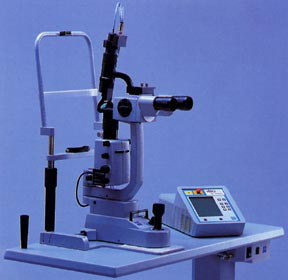Laser is a highly concentrated light that is beamed onto the retina to treat the desired area. It is a painless procedure.

Lasers are commonly used in the following conditions:
Diabetic Retinopathy– the damaged small vessels of the retina leak fluid and blood, causing swelling of the retina. These changes decrease vision if the central part is affected. Laser is done to seal these leaks. However laser is done to prevent or retard further loss of vision and not to improve vision. In severe changes when new blood vessels have grown (Proliferative Diabetic Retinopathy), multiple sittings of laser are needed to regress these vessels. This is called Pan Retinal Photocoagulation and is highly effective in preventing severe visual loss due to recurrent bleeding in vitreous.
Retinal tears and holes– In a retinal tear or a hole without a retinal detachment, laser is done prophylactically to seal the hole and prevent or limit the detachment.
Age Related Macular Degeneration– In patients with wet type of AMD not involving the central part, laser can be done to close the Choroidal Neovascular Membrane. This can prevent severe visual loss. However in patients with central involvement, other specific lasers are used like- Photo Dynamic Therapy (PDT) with verteporfin and Transpupillary Thermo Therapy (TTT) with Diode laser.
Other Retinal vascular disorders– like retinal vein occlusions and Eales disease also require laser at times. In venous occlusions, the central retina may swell up due to fluid collection leading to reduced vision. Such cases require laser to decrease the swelling, which may help in improving the vision. Venous occlusions may also lead to new vessel formation, which needs laser to regress these vessels. Similarly in Eales disease, laser is required to reduce recurrent vitreous hemorrhages. Laser is also useful in selected cases with Central Serous Retinopathy (CSR).
